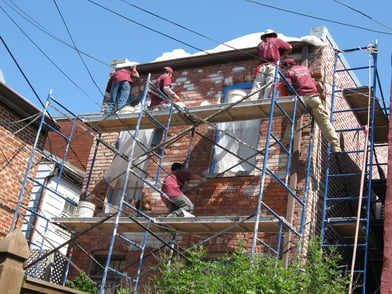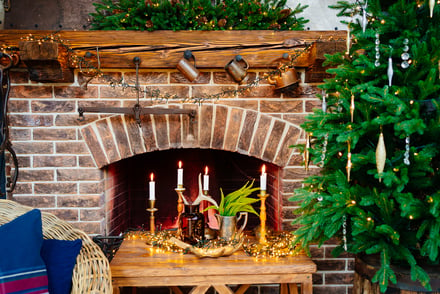While owning a historic brick home in DC is equivalent to possessing a fragment of history, there is no straightforward answer to how you should budget for renovations, since each home will come with its own set of necessary repairs. Historic brick home restoration and renovation requires a blend of reverence for the past along with updates to support today's amenities. Thankfully, there are several common areas among these cherished homes on which to focus your renovation dollars, ensuring each project adds structural and aesthetic value. If you own a fixer-upper, you'll need to create a smart budget for your historic brick home in DC.
Assessing Immediate Structural Concerns
Every homeowner of a fixer-upper house dreams of restoring crown mouldings, buying period furniture and antiques, and renovating their kitchen. However, before you delve into budget-busting shopping sprees, it's crucial to begin with the fundamentals. While it may not sound as rewarding as purely aesthetic updates, structural integrity is paramount to preserving your home for decades to come and protecting your interior work.
The brickwork is the heart of your historic home. Unlike a modern brick building, it usually lacks additional structural support. This means the brick is self-supporting, and compromising its condition jeopardizes your home's stability. Inspect the exterior brick, including the foundation bricks and mortar for cracks, crumbling, spalling or missing joints. Hire a historic brick expert who can help you identify areas of concern and give you the proper advice on how to correct the issues with period-appropriate tuckpointing repairs.
In addition to tackling brickwork, check your roof and gutters. Diverting water away from your historic brick home helps to prevent water from damaging the foundation. You may need to replace missing or damaged shingles, clean the gutters, or have their slope corrected to ensure water flows freely into the downspouts. The downspouts may need to be elongated to ensure water is moving far enough away from the house and not interfering with other areas of your yard or draining onto your neighbor's property.
Remember to inspect retaining walls, driveways, patios, porches, steps and walkways. Correcting problems in any or all of these areas can eliminate potential safety hazards.
Authenticity Matters When Restoring Historic Brick Homes
Once structural concerns are addressed, you can indulge in the interior structural components of restoration. Here, authenticity is key. In fact, you may be surprised to find bylaws that spell out what you can and cannot do when restoring your historic brick home. This is another area where a historic brick home renovation specialist can help you navigate your chosen upgrades.
Period-appropriate restoration often means sourcing materials that align with the home's era. It might mean salvaging materials from architectural antique stores or seeking artisans skilled in older techniques and materials. This doesn't prevent you from adding insulation or updating your electrical or plumbing. Budgeting for these items is critical to ensure you can reduce your heating and cooling costs in the years to come and enjoy the comforts of modern life without overloading your electrical system or struggling with insufficient plumbing that can't handle the amenities you want, like a dishwasher or high capacity washing machine.
Pay attention to your windows and doors when budgeting for renovations. Older windows and doors are rarely energy efficient, allowing outdoor air to affect your indoor climate. Historic windows and doors can sometimes be refurbished with weather stripping or adding salvaged storm windows. Still, it's usually better to budget for new windows and doors designed to mimic the look of the time period in which your historic brick house was built.
Planning for Your Long-Term Vision
With historic brick homes, you never know what you'll find behind walls, and unknown issues are bound to surface. Setting aside a contingency in your budget can cushion your finances against these surprises. In addition, it's a good idea to plan ahead for ongoing maintenance. Small investments can prevent significant, unexpected costs down the road.
Plan to have your brick inspected annually by a historic brick expert and budget for them to perform minor brick and mortar repairs where necessary. This prevents small problems from becoming big headaches. It's important to remember that even with routine upkeep, most homes will need a complete tuckpointing job by historic brick experts every quarter of a century.
As you settle into your home, consider sourcing period-appropriate furniture or décor. Finding pieces you love over time will make your home charmingly eclectic and it will naturally feel cozier. Invest in quality paints and wallpapers that are durable and enhance your home's inherent character. You can also add landscaping features to create some outdoor living space.
The joys of owning a historic brick home come with the commitment to its preservation. Some projects can wait, but it's wise to budget for them in the coming years. By prioritizing structural needs and progressively working towards aesthetic goals, you can confidently weave modern comforts into the fabric of history.
Renaissance Development, experts in traditional tuckpointing methods, specialize in brick repair and restoration projects in Capitol Hill and other historic neighborhoods in Washington, DC. We can provide a complimentary consultation and an estimate to help you budget for all your renovations. Contact us today - you'll get expert advice that you won't find anywhere else.
#historicbrickhome #historicbrickhomesDC #renovatinghistoricbrickhome #repairs #historicbrickhomerestoration #historicbrickhomerenovation #oldbrickhomesDC #tuckpointing
Tags:
Historic Preservation, Restoration, Renovation, Interior brick walls, Exterior brick, Research your old home, Tuckpointing job, Spot tuckpointing, Old brick chimney, Historic Integrity, Old Brick Home Inspection, historic brick home, historic brick, Clean A Historic Brick Home, Mold, Moss, and Mildew on Old Brick Walls, Historic Designation, Historic Designation DC, Historic Brick Home DC, Historic Preservation DC, Old Brick Home in DC8/24/23 8:45 AM


